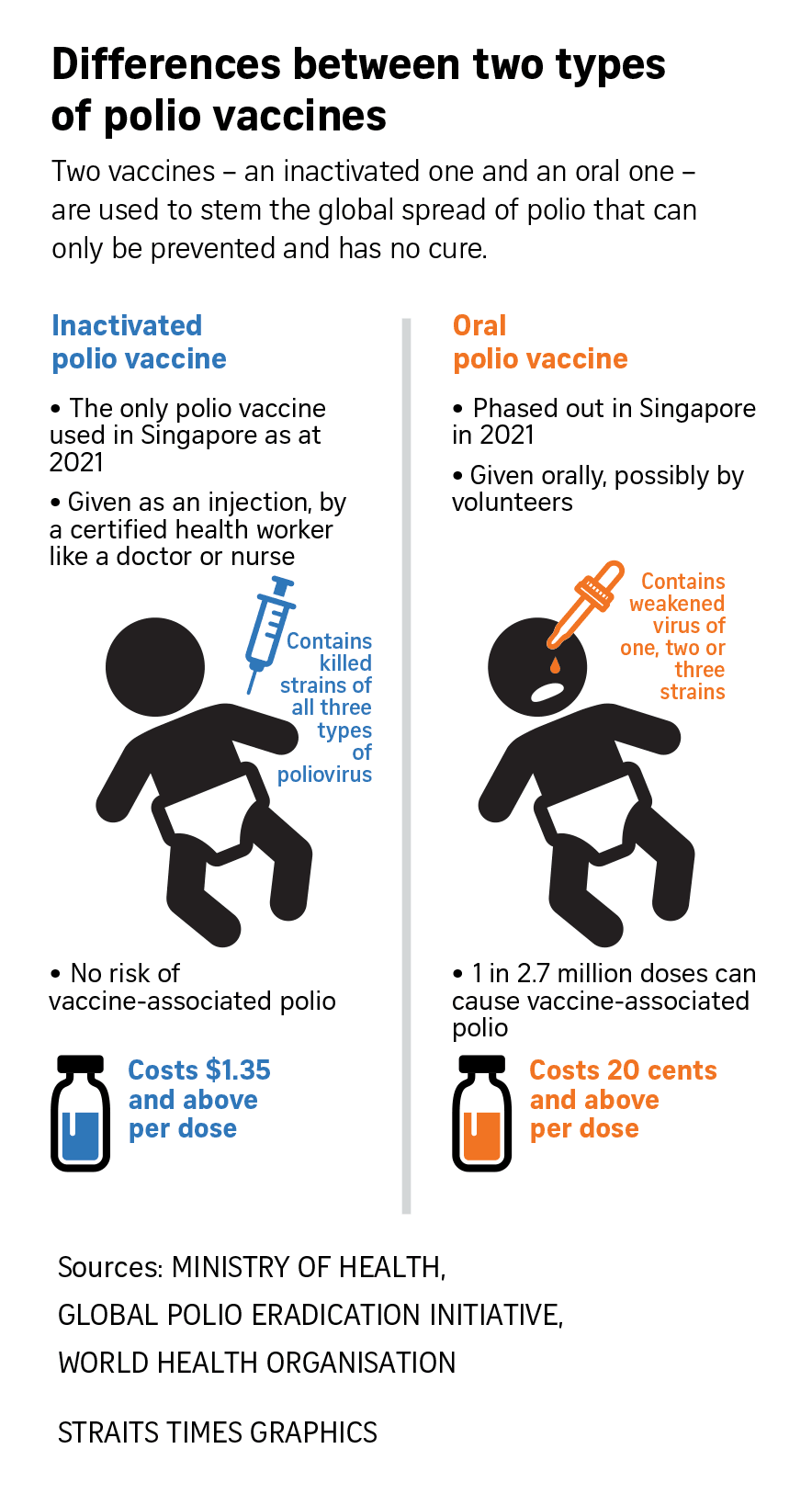Singapore’s imported polio case: What is polio? How do I protect myself against it?
Sign up now: Get ST's newsletters delivered to your inbox

A boy receiving a dose of polio vaccine in Pakistan. There is no cure for polio, but it can be prevented by being vaccinated against the disease.
PHOTO: EPA-EFE
Follow topic:
SINGAPORE – On Feb 7, a five-month-old Indonesian girl who arrived in Singapore for emergency medical treatment was confirmed to be a case of vaccine-associated polio.
According to the Ministry of Health (MOH), she was medically evacuated from Indonesia after displaying symptoms of fever, acute floppiness and paralysis of the lower limbs, and landed in the Republic on Jan 26.
Polio also made global news in August 2024, after a case of the disease was confirmed in Gaza
Though it was one of the world’s most feared diseases in the 20th century, the global incidence of polio has been largely reduced since the creation of a vaccine by American physician Jonas Salk in the 1950s.
In Singapore, no locally transmitted cases of polio have been recorded since 1978, said MOH. The last imported case – a two-year-old Nigerian girl – was in 2006.
But what does the disease involve, and what is behind its sporadic resurgence? How can we protect ourselves against it?
What is polio and how does it spread?
Polio, or poliomyelitis, is a viral infection caused by the poliovirus.
It was first clinically described in 1789 by a British doctor, Dr Michael Underwood, and was formally recognised as a medical condition by German physician Jakob Heine in 1840.
According to the World Health Organisation (WHO), the disease had spread worldwide by the mid-20th century, and killed or paralysed over half a million people each year.
Though the disease most commonly afflicts young children, those who survive live with its crippling consequences in adulthood.
Polio is highly contagious and can be transmitted from person to person. It is most commonly spread by the faecal-oral route, when the mouth of a susceptible individual comes into contact with the faeces of an infected person. It can also be spread, albeit less commonly, by contaminated water or food.
Once a human host is infected, the poliovirus then multiplies within the intestines, and may go on to invade the nervous system to cause paralysis, the global health authority said.
What are the symptoms of polio?
Polio is a disease which affects the muscles and nerves throughout the body, according to MOH’s HealthHub website. Some flu-like symptoms which may manifest in the beginning include:
Fever
Fatigue
Headache
Vomiting
Neck stiffness
Pain in the limbs
According to MOH, most patients will display no or minor symptoms, which often go away completely. Severe symptoms of the disease manifest in only a small number of patients, which may lead to the permanent paralysis of their limbs.
What are the different types of polio?
Wild poliovirus: There are three different strains of wild poliovirus – WPV1, WPV2 and WPV3.
Similar symptoms can arise from all three strains, and may result in eventual paralysis or even death, said WHO.
But with vaccination efforts worldwide via the Global Polio Eradication Initiative, WPV2 and WPV3 were fully wiped out in 2015 and 2019 respectively, WHO said.
To date, WPV1 remains endemic in only two countries: Pakistan and Afghanistan.
WHO estimates that the global incidence of wild poliovirus decreased by more than 99 per cent from 1988 to 2021 – from around 350,000 cases to just six.
Vaccine-associated poliovirus: This form of polio is a rare adverse effect of getting the oral polio vaccine (OPV).
Upon receiving the OPV, the weakened forms of live virus replicate within a patient’s intestines for about four to six weeks – producing antibodies which confer immunity.
During this period, the weakened poliovirus is also excreted in faeces.
In communities with low immunisation rates and inadequate sanitation infrastructure, these vaccine-viruses can circulate in the community for a long time.
They may then mutate over time to regain disease-causing abilities, thus spawning a strain of vaccine-associated poliovirus.
Such incidences remain rare, however, with only one case of vaccine-associated poliovirus observed for every 2.7 million doses of OPV administered, according to the Global Polio Eradication Initiative.
How can polio be treated or prevented?
There is no cure for polio, but according to WHO, it can be prevented by being vaccinated against the disease.
There are two main types of polio vaccines: the inactivated polio vaccine (IPV) and the oral polio vaccine (OPV). The former contains virus particles that have been killed, and thus cannot replicate and cause disease, while the latter has live but weakened poliovirus.

In Singapore, children receive five doses of the IPV under the National Childhood Immunisation Schedule, said MOH. Three doses are administered at the age of two months old, four months old and six months old, while two booster shots are given at 18 months old and 10 years old to 11 years old.
The OPV has not been used in Singapore since 2021, according to MOH.
As the OPV is cost-effective and easy to administer, despite the small risk it carries of causing vaccine-associated polio, it remains the most widely used polio vaccine globally.


